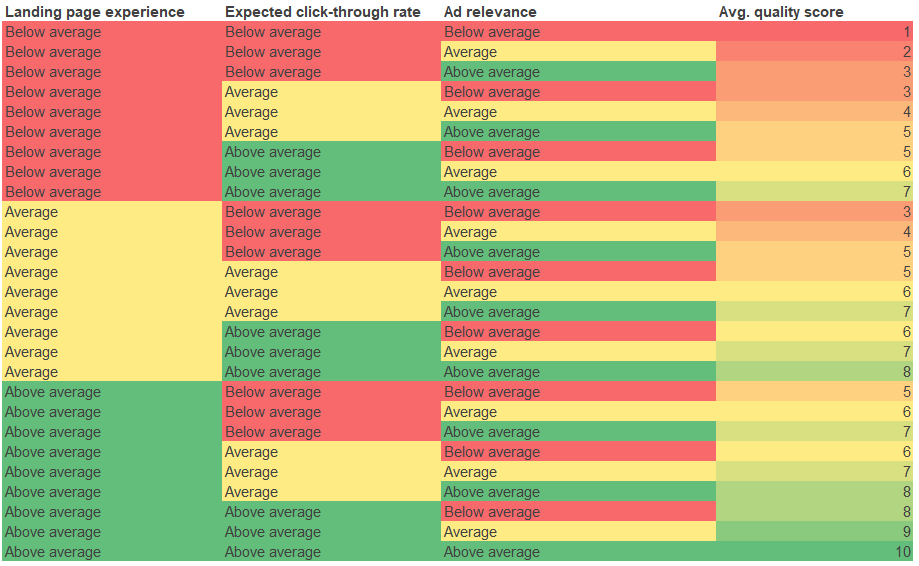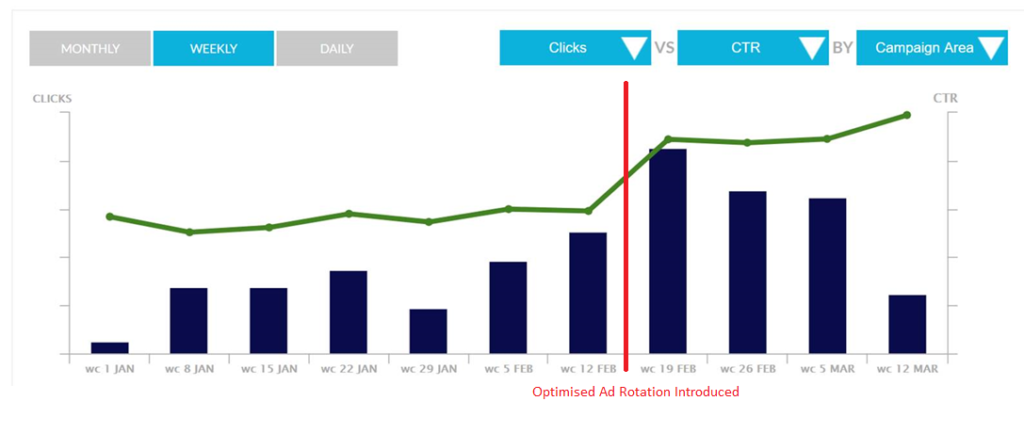
![]() Insights
Insights
Quality score is a useful indicator of how well your ads are likely to perform, but it can be difficult to figure out exactly where to focus on improving your ad quality.
In this post, we’ll break down how each factor is weighted in calculating a quality score, and how to improve ad quality for better performance and cheaper clicks.
In calculating the keyword quality score, expected click-through rate (ECTR) and landing page experience (LPE) are equally weighted and the most important, with ad relevance (AR) having less of an effect on the quality score.
To calculate a quality score from the factor ratings, you can use this formula:
Quality score = 1 + sum(factor weighting * factor score)
Where the factor weighting is 1.75 for ECTR and LPE, and 1 for AR and the Factor Score is 0, 1, or 2 for Below Average, Average and Above Average ratings. More information can be found in this article about reverse-engineering Adwords Quality Score factors.
You can also use this table:

Why would you want to do this when quality score is already visible in your account? It means that you can calculate the potential change in quality score from improving each aspect of your ad.
This might seem too simple, and it is: the quality score is not used at auction time to determine bid price. At auction, Google takes many factors into account, such as the exact search term, data about the user, and any ad extensions it decides to show. If you make changes and your quality score does not improve, this doesn’t mean they aren’t having a positive impact on your click prices.
Improving your landing page experience and expected CTR will yield the biggest rewards, but ad relevance is often easiest to fix.
Unless there’s some obvious reason not to, I would suggest focusing on the factors in this order:
You should also make sure that you have a full roster of extensions. This won’t directly improve quality score, but it will have a positive impact on ad rank and therefore click-through rates and click prices.
The first thing to check is whether you’re mentioning the keyword in all the ads. An easy way to do this is to split your keywords into very specific ad groups and put the keyword in headline one.
To use a classic example, if you have the keywords socks, striped socks, polka dot socks and where can I get socks online in one ad group and an ad that says:
Buy Patterned Socks – Hard-Wearing and Comfortable "Our socks have reinforced toes and cushioned heels for a long-lasting comfortable wear."
The best way to make the ad relevant is to split this into four ad groups, one for each keyword, and vary headline one to make sure you’re addressing the key components of the keyword.
Buy Socks – Hard-Wearing and Comfortable Our socks have reinforced toes and cushioned heels for a long-lasting comfortable wear. Striped Socks – Hard-Wearing and Comfortable Our socks have reinforced toes and cushioned heels for a long-lasting comfortable wear. Polka Dot Socks – Hard-Wearing and Comfortable Our socks have reinforced toes and cushioned heels for a long-lasting comfortable wear. Get Socks Online Here – Hard-Wearing and Comfortable Our socks have reinforced toes and cushioned heels for a long-lasting comfortable wear.
As you can see, leaving all the other parts of the ad the same but changing the headline cuts down on the time it takes to create relevant ads.
Keyword insertion is another way to make sure your keyword is in your ad text, but be careful. In this example, “where can I get socks online” doesn’t make sense as an ad headline, so you wouldn’t want to have it in a group with an ad using keyword insertion.
This is one of the easiest factors to deal with if it is below average, so doing this first will give you a quick boost of one point, while you work on the other factors that take longer to change.
Improving your landing page experience is going to reap rewards in both quality score and conversion rate. This will also reduce the cost per acquisition from two angles.
Unfortunately, this is usually the hardest factor to change, as development work may be required.
Assuming you’ve already selected the most relevant landing pages for each ad/keyword, you will want to look at these factors that will affect the landing page experience:
As more and more traffic shifts to tablet and mobile devices, mobile optimisation is not optional anymore. Even if you have a responsive site, you can make other improvements, like making sure contact forms appear near the top of the page on mobile and using Accelerated Mobile Pages (AMP).
Conversion rate optimisation (CRO) and SEO will have a knock-on effect on your paid search quality score. CRO will improve engagement, and part of a good SEO strategy is making sure you have relevant keywords on your pages. This is just one way in which an integrated digital marketing strategy can improve the performance of all your channels.
Unfortunately, there is no one easy trick to improve click-through-rate.
There are two different approaches you can take to improving this metric:
There are conflicting opinions on which of these is best practice, but either approach should make a difference to your click-through rate.
For a rigorous ad test, you need at least two ads on the rotate setting, with only one factor differing between them.
For example, you might run ads with two differing headlines: “Comfortable and Hard-Wearing Socks” and “100% Organic Cotton”.
After a few months, you should measure the difference in click-through rate across all ad groups, eliminate the one with the lowest CTR, and then test a new ad.
This has been industry standard for a long time and gives you a lot of control over messaging, but Google’s algorithms have been improving rapidly, and so we would now recommend using Google optimisation instead.
Google recommends using at least three ads in each ad group, all with a different approach, in order for it to optimise correctly.
For example, you might run these three ads in one of your sock ad groups:
Buy Patterned Socks – From Just £1.99/pair Organic cotton socks at low prices. Get your socks from Sock Warehouse
Beautiful Patterned Socks – Treat Your Feet 100% organic cotton and bold patterns for comfortable and fashionable feet.
Huge Selection of Socks – Over 1,000 Designs in Stock Choose your perfect pair from our enormous range.
If you then set the ad rotation to “optimise”, Google will then test these ads against each other, and use all the information it has to select the best ad for each search term and user.
This is the approach we would recommend, as Google has access to much more data than we do and can make decisions more effectively. Click-through rate can improve dramatically after introducing optimised rotation.

With Google’s new Responsive Search Ad format, the platform is doubling down on this approach. The platform will test different combinations of headlines and descriptions to try and maximise the click-through rate. The format is still being rolled out, so make sure to have at least one text ad as well, but it’s worth testing to improve click-through rate.
SEO, programmatic, website translation and CRO all interact with and can boost PPC, whether by increasing brand trust, affecting conversion rate, or simply introducing people to the brand. One of the key areas where an integrated approach can bring benefits is in ad rank and quality score.
Making sure you have the appropriate keyword density on the landing page is one area where PPC and SEO can work together. Improving the on-site content can also create a better landing page experience.
Programmatic advertising creates users at the top of the sales funnel, who then later come back through, mostly, brand searches. However, programmatic can also increase brand recognition and trust, which has an impact on the click-through rate of non-brand PPC ads. Although beware, spammy ads can decrease brand trust and have a negative impact.
If you’re trading internationally, translation is key to the landing page experience.
Google doesn’t use conversion rate in its calculation of landing page experience, as this would be too easy to “hack” by creating false conversions. However, one of the cornerstones of CRO is creating a better and more streamlined user experience, which should be recognised by Google through a lower bounce rate, more pages visited and increased site interaction.
There are some things that are not baked into a quality score but can improve your ad rank. It can be dangerous to focus on the quality score as a performance metric because you can achieve the same result (higher positions, cheaper clicks, higher click-through rate) through other means, which can be easier. Some examples include:
When calculating your ad rank at auction time, Google will take into account the impact of any extensions that will show along with the ad. Every account should have callout extensions at the very least, and ideally, every relevant extension should be enabled. Adding extensions is often easier than changing your landing page or running an ad test.
Google calculates ad rank based on the exact match search term for your keyword, even if your keyword has a different match type. Adding negative keywords does not affect your quality score since it does not have an impact on exact-match queries. However, adding negative keywords has many benefits. While irrelevant clicks can result in wasted spend, irrelevant impressions can harm your brand. If you search for “recipes using dates” and get an ad for “single people looking for dates”, your impression of that company will be negative because they have impeded your search.
The main things to remember when trying to raise your ad rank are:
Want insights like these delivered straight to your inbox?Sign-up now

![]() Insights
Insights

![]() Insights
Insights

![]() Insights
Insights